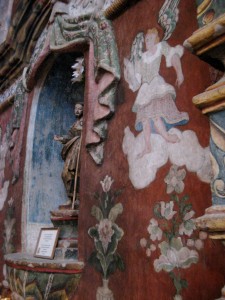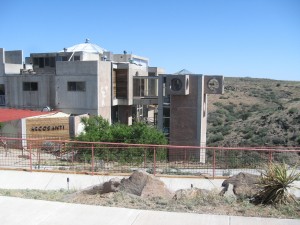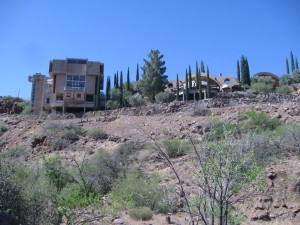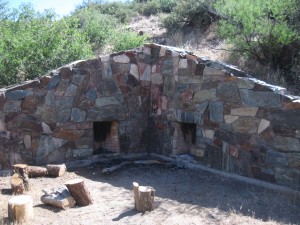
http://servuclean.com/bkp2 The things you can do with cactus juice plaster.
Sambriāl My last full day in Tucson was a Sunday, and the visit of a friend gave me a perfect opportunity to visit San Xavier del Bac one more time. I hope to write a bit more about this extraordinary church, which to my mind is the most extraordinary building and artwork in Arizona. After mass I lifted the head of San Xavier for luck or protection, and my friend and I took a desert stroll from Tubac to Tumacacori, where we visited a desert cantina where I had once been treated nicely. We played some pool, slaked our thirst, and walked back to Tubac along the old trail. The trail had been used by Juan Batista de Anza, the governor of the area, when he set out for the Pacific Coast to establish a new mission more than a thousand miles away – Mission Dolores, also known as San Francisco. Our four miles along the trail made us both wonder about continuing the walk to San Francisco. Obviously enough the de Anza trail must have run along the Santa Cruz River to the Gila to the Colorado, but how did he go from the Colorado to San Francisco? The thought of crossing the Mojave by foot or beast had us both measuring our own hardihoods.
The next day I packed my car and cleaned my room. My landlady insisted on fleecing me of some money before my departure, knowing with that savage human cunning that I was not going to haggle over the price of a freedom that now was very near. But in all such matters I go like a sheep to the shearer. But I said I would be on the road by noon, and at 11:50 I was heading down the driveway.
Melancholy clung to me all the way. I’m not quite sure why – I suppose something felt undone, or inconclusive. I came here alone five months ago, and five months later I was alone again. I had sixteen hundred bucks in my bank account but that felt like the only difference.
I was to see an old friend in Prescott, but being a little ahead of schedule I stopped at a place called Arcosanti. Trapped as I had been in the quotidian of middle-class salary-earning, I hadn’t seen much in Arizona of the unusual: and Arcosanti was supposedly a city in the making, a “urban laboratory” to explore “arcology,” or the meeting-place of architecture and ecology. My guide book promised good things:
This cross between a kibbutz and design school 65 miles north of Phoenix looks like a village on Luke Skywalker’s home planet. Radical when conceived in the 1960s, Soleri’s ideas now seem cutting-edge in this age of urban sprawl and global warming.
The city was being planned to support 5,000 people sustainably and ecologically. Even if this was not possible, it was “a groovy stop-off if you’re driving from Phoenix to Sedona.”
 I could feel the disappointment coming as I drove down the dirt road to the place: the dirt road suggested a place that the future had already forgotten. I got off at the empty parking lot and could feel the nothing: no noise, no people, no children, no flowers, no life. There were only a few buildings, built at the edge of a dry gulch – what was the obsession in the 60s with building on slopes? The ground floor on one side was the third floor on the other side. The materials were of the cheapest and ugliest – concrete – to suggest thrift, although the shapes were weird and difficult. This was not the kind of thing you could reproduce by yourself in the desert.
I could feel the disappointment coming as I drove down the dirt road to the place: the dirt road suggested a place that the future had already forgotten. I got off at the empty parking lot and could feel the nothing: no noise, no people, no children, no flowers, no life. There were only a few buildings, built at the edge of a dry gulch – what was the obsession in the 60s with building on slopes? The ground floor on one side was the third floor on the other side. The materials were of the cheapest and ugliest – concrete – to suggest thrift, although the shapes were weird and difficult. This was not the kind of thing you could reproduce by yourself in the desert.
I entered a hallway, and on my right was a loosely connected structure containing the staircase. A sign said there was a cafe and the “visitors’ trail” down the stairs, so I descended. The staircase looked like every other concrete staircase in every bad 60s building. Poured concrete and unadorned metal rails. Posters on the walls touted the architect – my thought was that he had four hundred years to improve on Borromini and had failed.
 I entered the cafe, which was a lofty concrete rectangle with no one in it. It was a “self-service” cafe. They had some drinks there and some sandwiches. You put money into a basket. The desolation was doubly impressive because it did not make me curious to poke around: it just made me feel like an intruder, and I wanted to leave. I went out to the visitors’ trail, which crossed the gulch seemingly without purpose. An odd fireplace was there, looking like the most unsatisfactory fire pit human beings have ever made. Looking back at Arcosanti it had some silly Italian cypresses, which looked out of place in the Arizonan desert – but in fact, the whole thing looked out of place. Architecture was hardly meeting ecology at all. It was just lines on paper. Nothing looked organic at all.
I entered the cafe, which was a lofty concrete rectangle with no one in it. It was a “self-service” cafe. They had some drinks there and some sandwiches. You put money into a basket. The desolation was doubly impressive because it did not make me curious to poke around: it just made me feel like an intruder, and I wanted to leave. I went out to the visitors’ trail, which crossed the gulch seemingly without purpose. An odd fireplace was there, looking like the most unsatisfactory fire pit human beings have ever made. Looking back at Arcosanti it had some silly Italian cypresses, which looked out of place in the Arizonan desert – but in fact, the whole thing looked out of place. Architecture was hardly meeting ecology at all. It was just lines on paper. Nothing looked organic at all.
And for that reason, no one wanted to live there.
I’m not giving up on the idea of sustainable architecture. But to me the ideal is a place like San Xavier del Bac, where they are literally making desert plaster for the church out of cactuses – all local and sustainable ingredients. And where there is always life and beauty, and where little children come in and say “wow.” This is organic and sustainable – where there are few straight lines because hands don’t make things straight.
I read that Arcosanti is conceding that no one wants to live there, and it will not become a city, and so is looking into other options.

Post a Comment